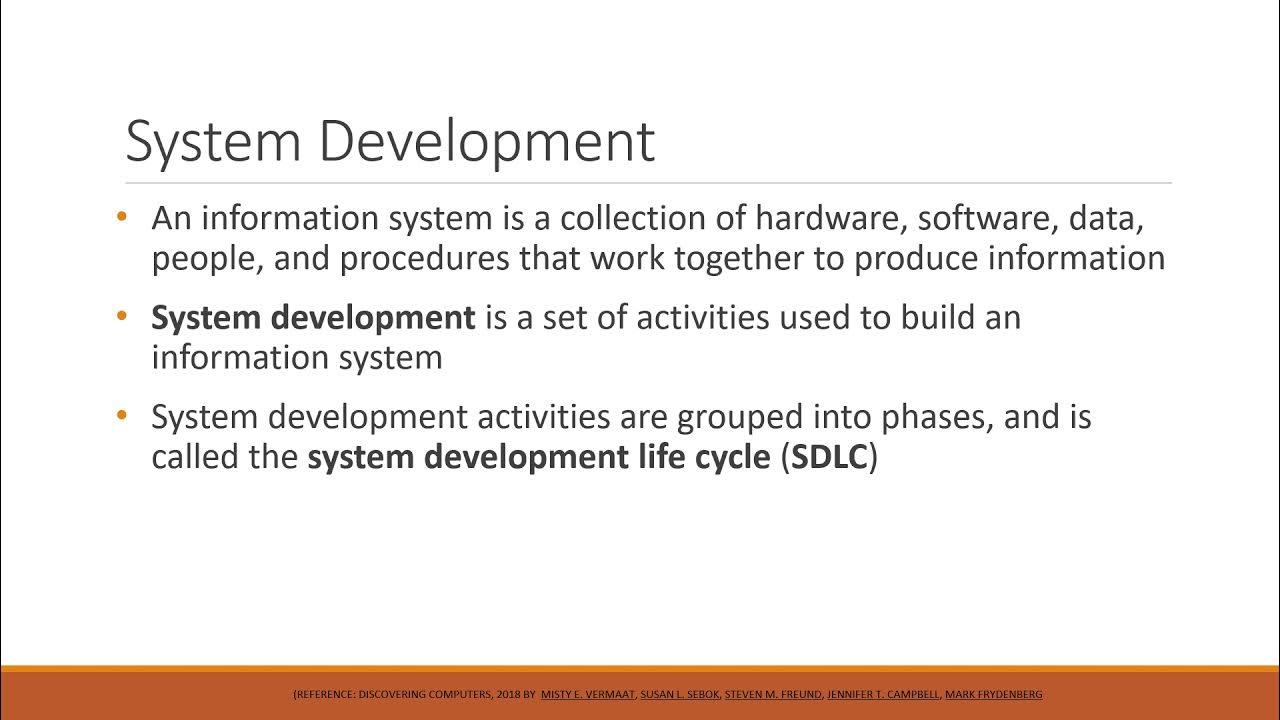Choosing the Appropriate Development Approach: Traditional
Summary
TLDRThe video introduces the traditional approach to system development, known as the System Development Life Cycle (SDLC). It outlines a structured, step-by-step process starting with understanding the problem and gathering system requirements, followed by planning, design, implementation, testing, evaluation, and maintenance. The process emphasizes assessing feasibility, selecting the best solution, training users, and ensuring the new system meets initial requirements. The cycle is iterative, with maintenance and updates ensuring the system remains relevant and functional over time.
Takeaways
- 😀 The traditional approach to system development follows a structured, step-by-step process.
- 😀 The System Development Life Cycle (SDLC) is the core framework for developing projects systematically.
- 😀 The first step in SDLC is 'understanding the problem' by investigating the existing system and its requirements.
- 😀 'Planning' comes after understanding the problem and focuses on applying the gathered requirements to the new system.
- 😀 'Designing' involves modeling the new system and building it according to the outlined requirements.
- 😀 'Implementation' is the phase where the new system is developed, and the old system is replaced.
- 😀 In the 'implementation' stage, it’s important to plan how data will be transferred and how users will be trained.
- 😀 The 'Testing, Evaluating, and Maintaining' stage ensures the new system meets initial requirements and is free of bugs.
- 😀 Regular maintenance and updates are essential to ensure the system remains functional and relevant over time.
- 😀 The SDLC is cyclical: after maintenance, the process returns to 'understanding the problem' for potential future improvements.
Q & A
What is the System Development Life Cycle (SDLC)?
-The System Development Life Cycle (SDLC) is a structured process consisting of a series of steps that are followed to develop a project. These steps are conducted in order to ensure the successful creation of a new system, beginning with understanding the problem and ending with maintaining the system over time.
What is the first step in the SDLC process?
-The first step in the SDLC process is understanding the problem. This involves investigating the existing system to identify issues and determining the requirements for a new system that can address these problems.
What is involved in the planning phase of SDLC?
-In the planning phase, the requirements gathered during the understanding phase are reviewed, and opportunities for applying new technologies are explored. The team assesses what can be improved with the new system and prepares a feasibility study based on four criteria: economic, schedule, operational, and technical.
What are the four criteria of a feasibility study in SDLC?
-The four criteria of a feasibility study are: economic (financial considerations), schedule (time constraints), operational (the skills required by participants), and technical (the technology needed to run the system).
What happens during the design phase of the SDLC?
-During the design phase, the new system is modeled. This includes clarifying the benefits of the new system, creating detailed designs, and beginning the development process for the new system.
What is the role of the implementation phase in SDLC?
-The implementation phase involves developing the new system, converting from the old system, and ensuring the new system is operational. It also includes training participants and providing resources like operation manuals to support the transition.
What does the testing, evaluating, and maintaining phase ensure?
-The testing, evaluating, and maintaining phase ensures that the new system works properly and meets the original requirements. Testing is used to identify and fix bugs, evaluation checks if the system satisfies the initial goals, and maintenance ensures the system remains functional over time.
What is the importance of maintenance in the SDLC?
-Maintenance is crucial in the SDLC to keep the system up-to-date, address issues promptly, and ensure its continued effectiveness. This includes regular updates, bug fixes, and responding to any problems that arise during operation.
How does the SDLC loop work over time?
-The SDLC is cyclical. After maintaining a system, the cycle begins again with understanding the problem when new technologies or requirements emerge. This ensures that the system evolves to meet changing needs over time.
How does the traditional SDLC process differ from more modern approaches?
-The traditional SDLC is a structured, sequential process where one stage must be completed before moving to the next. This contrasts with more modern approaches like Agile, which focus on iterative development, flexibility, and ongoing adjustments throughout the project lifecycle.
Outlines

此内容仅限付费用户访问。 请升级后访问。
立即升级Mindmap

此内容仅限付费用户访问。 请升级后访问。
立即升级Keywords

此内容仅限付费用户访问。 请升级后访问。
立即升级Highlights

此内容仅限付费用户访问。 请升级后访问。
立即升级Transcripts

此内容仅限付费用户访问。 请升级后访问。
立即升级5.0 / 5 (0 votes)






